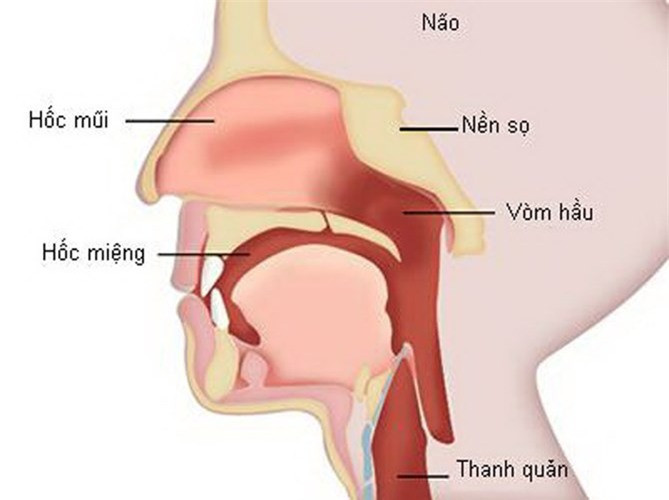How to recognize early types of head and neck cancer
Head and neck cancer arises in the nose, tongue, cheeks, throat, tonsils, larynx, salivary glands, thyroid glands; symptoms of nasal bleeding, upper jaw pain, voice changes, difficulty swallowing .
According to Dr. Lim Hong Liang, PCC Cancer Center, Singapore, head and neck cancer is a very common disease. This group of cancer arises in the nose, tongue, cheeks, throat, tonsils, larynx, salivary glands and thyroid gland. Depending on the location of cancer development, symptoms manifest differently:
Nasal cancer: In the early stages, common symptoms are chronic sinusitis that does not respond to treatment with antibiotics, nasal hemorrhage, chronic headache, eye swelling, upper jaw pain, problems with dentures. .
Laryngeal cancer: The patient has a voice change, a feeling of difficulty swallowing.
Cancer of the tongue, cheeks, throat, tonsils: A benign ulcer lasts more than a few weeks, bleeding from ulcers, blood in the sputum, prolonged earache, difficulty swallowing.
Salivary gland cancer: Has a tumor or swelling in the face, neck and mouth, a feeling of partial facial numbness, facial weakness on one side.
The method to diagnose cancer is a biopsy . Today, many cancers and head and neck can be cured by early detection and thorough treatment including surgery, radiation and chemotherapy.

Some sites of cancer in the head - neck area.(Photo: ungbuou).
On the other hand, Tan Hui Yong speech therapist at Mount Elizabeth Rehabilitation Center, noting the pathology of head and neck cancer and the treatment process often changes speech, language and ability. swallowing, affecting the quality of life as well as the ability of the patient to function socially. A speech therapist is required to make it easier for patients to face difficulties, and there are therapeutic remedies to address problems related to speech, language and swallowing.
Usually, speech therapists work psychologically and intervene with patients before, during and after treatment to keep them able to communicate and swallow as often as possible. In cases where it is compulsory to remove the larynx, the patient is incapable of speaking by mouth, there is an alternative method such as using external communication devices. The doctor instructs the patient how to speak from the esophagus (speaking by pushing air to the feeding tube), or using an electronic artificial larynx capable of producing sounds. Some cases of pseudo-esophageal gas (TEP) fitting , patients speak through a small one-way valve to transfer air from the trachea to the throat.
The common condition of patients after head and neck cancer treatment is difficulty swallowing, difficulty eating and drinking . The muscles responsible for swallowing may be weak and reduce the ability to move due to side effects of radiation therapy or scarring after radiation therapy. This condition causes the patient to eat longer, difficulty in swallowing dry food, food stuck in the throat after swallowing, food or liquid flowing from the nose, coughing and choking during or after swallowing. If left untreated, the patient may be malnourished and dehydrated, severe pneumonia and chronic lung disease.
In addition to the above symptoms, many cancer patients also lose interest in eating and depression, separate from society. To remedy this situation, the speech therapist will assess the ability to swallow, may prescribe throat endoscopy. Based on each patient's condition, the doctor gives advice to make appropriate adjustments, such as changing positions, diets or using tips to swallow. If the patient is unable to swallow safely despite the use of recovery methods, the doctor considers the alternative feeding method combined with swallowed muscle recovery therapy.
Recent studies have shown that patients who receive speech therapy and the ability to swallow before radiation therapy have better results in maintaining muscle structure and swallowing function. To achieve optimal results, doctors recommend that patients begin the treatment process from before, during and after cancer treatment. In fact, interventions to improve language ability and swallowing function developed before cancer treatment helped maintain muscle function and improve patient quality of life later.
- Compound from magnolia can treat head and neck cancer
- Foods that can help you prevent head and neck cancer
- Kisses can spread HPV viruses
- The HPV vaccine can prevent cancer of the neck and head
- Discovered 231 new genes related to head and neck cancer
- Coffee can help prevent head and neck cancer
- Aspirin reduces the risk of head and neck cancer
- The culprit causing throat cancer should be avoided
- Compounds in fruits are resistant to head and neck cancer
- Cancer patients need only 6 radiation treatments thanks to new techniques
- Thyroid cancer: How to detect and treat
- The cancer has no symptoms early
 New drug causes cancer to 'starve'
New drug causes cancer to 'starve' Why is Australia the country with the highest cancer rate in the world while Vietnam ranks 100th?
Why is Australia the country with the highest cancer rate in the world while Vietnam ranks 100th? Common cancers in men
Common cancers in men America's incredible discovery: The most feared cancer cell is love
America's incredible discovery: The most feared cancer cell is love